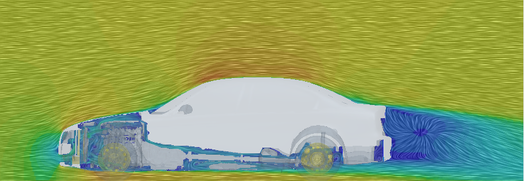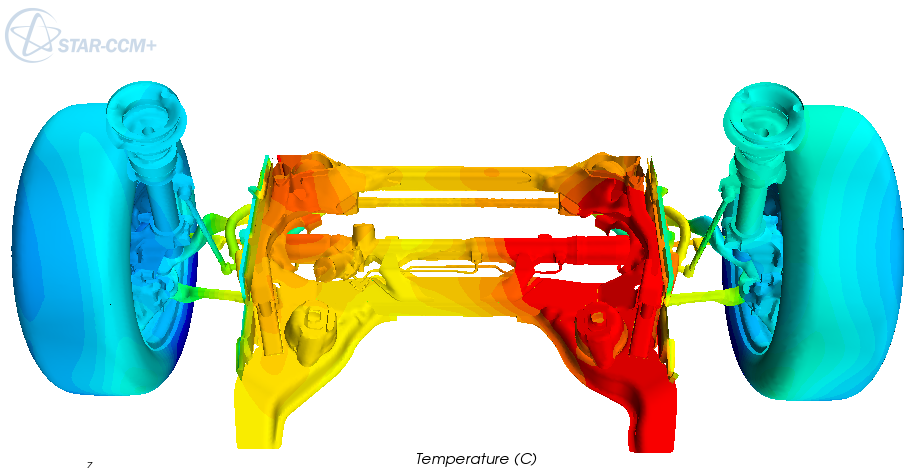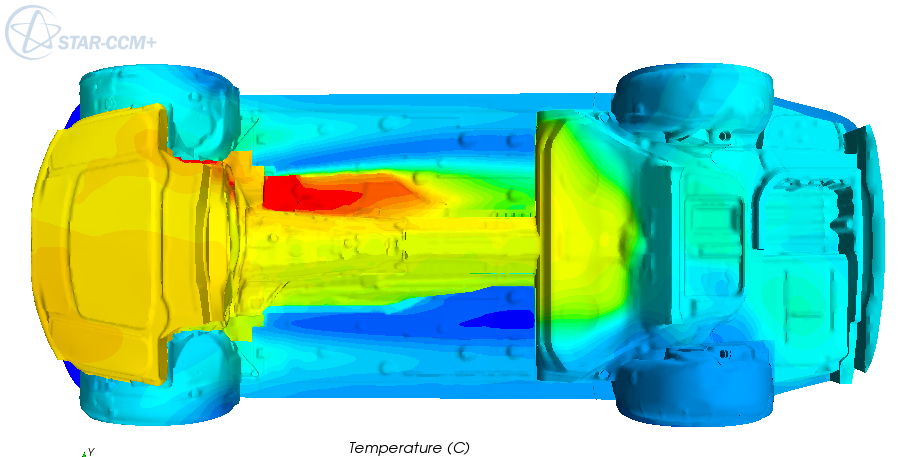Automotive Thermal Management
Tabbed contents
Reference Applications
Concerning the thermal behavior of automotive vehicles, it is pursued to accomplish simulations for the full complexity of a vehicle's geometry and transport phenomena of heat including convection, radiation and conduction in fluids and solid bodies. The different heat transport mechanisms described are solved by specialized codes. The coupled approach supports steady state, transient and mixed type (quasi-stationary with transient) applications.
MpCCI CouplingEnvironment offers the possibility to couple your favorite CFD-Code with a code that is specialized to radiative and solid body conduction heat transfer. Furthermore, it is possible to integrate your own inhouse code into the MpCCI environment.
Co-simulation of BMW full Passenger Car
This application comprises a steady state approach coupling STAR-CCM+ and RadTherm (TAITherm) for a full BMW passenger car with the following features:
- Flow model : 45 mio. cells, MRF for fans and wheels, porous regions for heat exchanger and cooling devices
- Radiation model: 1 mio. cells, fluid parts for exhaust system
- MpCCI: 2 mio coupled surface cells , coupling wall temperature and heat coefficient with film temperature, extrapolation of coupled quantities for geometric deviations activated
- Shell parts in RadTherm coupled with thin layer solids in STAR-CCM+
Integration into the End-User’s CAE Workflow
MpCCI CouplingEnvironment integrates new features for the full-vehicle co-simulation setup. The enhancements provide the user some automated model verification for setting the co-simulation for complex vehicle's geometry. Any troublesome issues, e.g. unit system incompatibilities, model connectivity (unwanted thermal disconnection), etc. from an earlier modelling stage can be detected. The model needs additional modifications prior to the co-simulation run. In addition to the automated verification step, MpCCI CouplingEnvironment offers an automated component association search. A list of component pairs is proposed to be combined for the co-simulation. Furthermore, the user can visualize the resulting number of orphans for each component association and check for incompatibilities. The user can tune the neighborhood search parameters on the selected association. In a final step, a validation of the newly created coupled regions can be performed by recalculating the number of orphans. These co-simulation preparation steps provide a high turn-around time for simulating different scenarios.
MpCCI Methods

Features for Thermal Management
In order to compute the stationary and transient thermal behavior of “complete” automotive vehicles, MpCCI CouplingEnvironment offers the possibility to couple your favorite CFD-Code with a code that is specialized to radiative and solid body conduction heat transfer. MpCCI offers a large variety of methods to overcome common known problems like geometry deviations or stability problems:
- The MpCCI CoupingEnvironment/FSIMapper provides various specific solutions for thermal management:
- Combining CFD with dedicated radiation code
- Robust and highly efficient mesh-to-mesh interface handling
- Flexible and scalable parallelization strategy (per code …)
- MpCCI offers a number of advanced and specific features …
- Stationary and transient simulation set-ups
- Parallel coupling procedures for faster simulation times
- Extrapolation methods for geometry deviations
- Variety of coupling methods, e.g. asynchronous coupling, interpolation in time, etc.
- Easy set-up and runtime visualization of coupled regions
Realization of new Methods and Solutions within R&D Projects
- Coupled models for thermal management:
- Enhancements for automated coupling set-up for a large number of coupling regions
- Implementation of algorithms to speed-up convergence
- Advancements concerning coupled transient problems with regard to model size reduction (e.g. quasi-stationary…
Software and Services
Service Offer
- Integration of commerical or inhouse codes into the MpCCI tools
- Integration of MpCCI tools into customer’s CAE workflow
- Adjusting MpCCI to customer’s specific requirements
MpCCI CouplingEnvironment
The MpCCI CouplingEnvironment offers flexible solutions for multiphysical simulations. The combinable simulation codes for this application area are shown in the following table:
Discipline |
Codes |
|---|---|
Fluid |
|
Heat Transfer |
|
The supported quantities in this context are:
Quantities |
|
|---|---|
Thermal |
|
MpCCI FSIMapper
The MpCCI FSIMapper maps simulation results from a source to a target mesh. The following two tables list the supported source and target file formats for this application area.
Source Formats |
Quantities |
|
|---|---|---|
CFD |
|
temperature heat flux film temperature, heat coeff. |
Target Formats |
Target Analyses |
|
|---|---|---|
FEM |
|
stress heat transfer |
List of additionally supported source and target file formats


